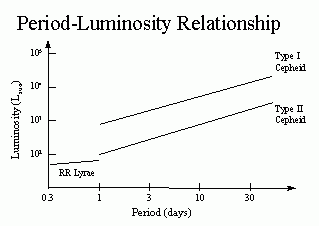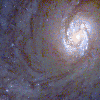Astronomy 162: Professor Barbara Ryden
Wednesday, January 29
PULSATING STARS
``But I am constant as the Northern Star
Of whose true-fixed and resting quality
There is no fellow in the firmament.''
- William Shakespeare,
Julius Caesar, 3, 1
Key Concepts
- Some giants and supergiants vary in luminosity because
they pulsate in and out.
- Cepheid stars and RR Lyrae
star are examples of pulsating variable stars.
- The greater the luminosity of a Cepheid star, the longer
its period of oscillation.
(1) Variable stars have luminosities which increase and decrease
with a regular period.
Main sequence stars have a nearly constant luminosity. (During the
next five billion years, the Sun's luminosity will double; that's
an increase of only 0.02% every million years.)
By contrast, some giants and supergiants have luminosities which
regularly increase and decrease. The period of the luminosity
fluctuations (that is, the time between peaks in the brightness)
can range from a few hours to a few years.
(2) Cepheid stars and RR Lyrae stars are variable because they
pulsate in and out.
The two most interesting types of variable star are Cepheid
variables and RR Lyrae variables.
Cepheid variables are named after the star Delta Cephei (the
fourth brightest star in the constellation Cepheus). The
luminosity of Delta Cephei varies by a factor of two, with
a period of 5 days. Polaris, the Northern Star, is also a Cepheid.
(Thus, when Shakespeare has Julius Caesar say ``I am constant
as the Northern Star'', astronomically knowledgeable playgoers
may savor a double irony.)
Cepheid variables have the following properties:
- Period = 2 to 60 days
- Average Temperature = about 6000 Kelvin
- Average Luminosity = 300 to 40,000 Lsun
The fluctuations about the average luminosity can be large
(as in the case of Delta Cephei) or small (as in the
case of Polaris, where the fluctuations are too small to
be detected with the naked eye).
RR Lyrae variables are named after the star RR Lyrae, in
the constellation Lyra.
RR Lyrae stars have the following properties:
- Period = 4 hours to 1 day
- Average Temperature = about 7000 Kelvin
- Average Luminosity = about 80 Lsun
RR Lyrae variables thus have shorter periods and lower
luminosities than Cepheid variables.
The variation in the luminosity of RR Lyrae and Cepheid stars
results from the fact that they pulsate in and out. The radius
of a Cepheid can vary by as much as 10 or 20 percent. (Remember that
a giant or supergiant star such as a Cepheid or RR Lyrae variable
has a small dense core and a large, low-density envelope. In the
case of a Cepheid or RR Lyrae variable, it is only the envelope
which expands and contracts. The core remains constant in
size, and continues to produce energy at a steady rate.)
As the envelope expands and contracts, its surface temperature varies
by as much as 1000 degrees Kelvin.
Because the radius R and surface temperature T change, so does
the luminosity L. Remember,
L = 4 pi R2 sigma T4
But why does the star pulsate at all??
The textbook has a rather involved description involving
the properties of a layer of ionized helium in the star's
envelope. A simpler, stripped-down explanation goes something
like this:
- When a Cepheid is compressed, it becomes opaque.
- Photons are trapped inside, heating the gas and increasing its pressure.
- The high-pressure gas expands, becoming transparent.
- Photons escape, the gas cools, the pressure drops.
- As the pressure drops, the Cepheid is compressed by gravity.
This cycle repeats as long as the Cepheid (or the RR Lyrae, which
pulsates by the same mechanism) is in the instability
strip, the region of the H-R diagram where stars are
unstable to pulsation.
(3) The greater the luminosity of a Cepheid star, the longer
its period of oscillation.
It was discovered empirically in 1912, by the Harvard astronomer
Henrietta Leavitt, that a Cepheid's period of pulsation is
linked to its luminosity. (This was long before
anyone knew WHY Cepheids varied in luminosity.)
Miss Leavitt was studying Cepheid
variables in the Large Magellanic Cloud (a nearby galaxy)
when she discovered that the brightest Cepheid variables
in the galaxy had the longest period of pulsation. This
relation holds true in our own galaxy too, and in all
other galaxies where Cepheid variables have been detected.
High Luminosity, Long Period.
For instance, a very luminous Cepheid, with L = 40,000 Lsun,
has a very long period, P = 60 days. On the other hand, the
dimmest Cepheids, with L = 300 Lsun, have short
periods, P = 2 days. A plot of the period-luminosity relation
for Cepheid variables (as well as for RR Lyrae variables)
is shown below:

(A complicating factor: There are two types of Cepheids. In
addition to the standard Type I Cepheids that I've been
discussing, regions of the universe which have few heavy
elements give rise to a different species of Cepheid: Type II.
Type II Cepheids, because they have a different chemical
composition, have a different period-luminosity relationship.)
The Period-Luminosity relation is useful because
it lets you measure the distance to Cepheid stars
which are quite far away.
- Measure the period P of a Cepheid variable.
- From the period-luminosity relation, determine the luminosity L.
- Measure the apparent brightness b.
- Compute the distance from the equation: L = 4 pi d2 b
Because Cepheids are so luminous, they can be seen to large distances.
Parallaxes can be used to determine distances to 500 parsecs or so.
However, the period-luminosity relation can be used to determine
the distance of a Cepheid about 40 MILLION parsecs away. This
lets us find the distance to all the galaxies in our neighborhood.
(At least all the galaxies which contain Cepheid variables - Cepheid
stars are rare, and must be hunted for carefully.)
The galaxy M100 is 17 million parsecs (56 million light years)
away -- 25 times farther than the Andromeda
galaxy. The distance to M100 was determined from the bright
Cepheid stars within the galaxy, which are visible using
the Space Telescope. Click on the image of M100 below, and
you will see six snapshots of an extremely
luminous Cepheid in that galaxy, varying
with a period of 51 days.
(Image credit: J. Trauger, [Jet Propulsion Laboratory], & NASA)

Cepheid variables are a vital tool for measuring the distances
of relatively nearby galaxies (out to about 40 million parsecs,
or 130 million light years). RR Lyrae stars can also be used
to measure distances, but since they are less luminous, they
can only be seen to smaller distances.
Prof. Barbara Ryden
(ryden@astronomy.ohio-state.edu)
Updated: 2003 Jan 28
Copyright © 2003, Barbara Ryden

